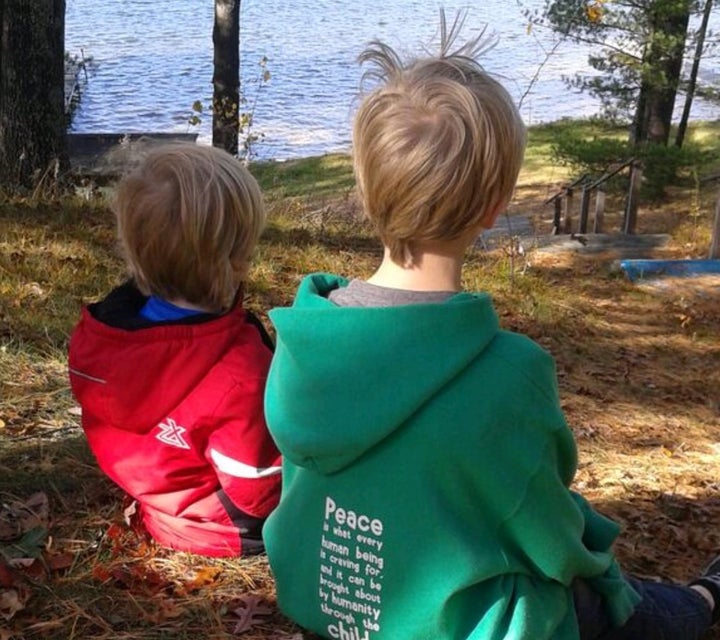
It’s October, and my eighth-grader is late getting home from school. “Where are you?” I text as I walk out the door to pick up my youngest. I expect him to say the bus is running late or that there’s a sub who doesn’t know the route ― replies I’ve heard in the past. What I get instead is so unexpected and upsetting I can barely understand it.
My kid’s bus was attacked by teenagers. They’re now flanked by police cars, getting wounds examined, and giving witness statements.
Over the next half an hour, I piece together what’s happening through texts and phone calls with adrenaline-filled kids in the background. A few stops back, my child says, some teens shot into the bus with Airsoft pistols. Students on the bus hit the floor, unsure if it was the real deal. One person threw a brick into an open window, hitting a kid in the head.
The bus driver pulled away and went around the corner, pausing to radio dispatch for help. The teens followed on foot, my son tells me, lifting their shirts to flash the Airsoft guns tucked into their waistbands.
The driver then took the bus about a mile from where the attack had occurred.
“I think about how our kids prepare for unimaginable moments from the time they’re tiny kindergartners, making their desks into barricades and hiding quietly in closets. Maybe it’s instinct that tells the kids to hit the deck, or maybe it’s years of hypervigilance and anticipating an inevitable nightmare.”
I pull up to my first-grader’s school while still on the phone with my son. I ask him how much longer they are going to be there.
“I don’t know,” he says. “I’m going to ask if I can just walk home, we’re just a couple of blocks from our house now.”
I scan the perimeter of the school for my youngest. I’m too stunned to talk to anyone, and I don’t want to make unnecessary small talk today. I see her and wave. She waits for me to indicate that she can cross the street to where I’m waiting by the car.
I call my partner to tell him what is happening. On the drive, everything is bouncing around in my brain like a game of pinball. Thoughts about why it happened, why someone would do that, and whether our kids are ever safe prevent me from engaging in the usual back-and-forth with my first-grader.
I think about how our kids prepare for unimaginable moments from the time they’re tiny kindergartners, making their desks into barricades and hiding quietly in closets. Maybe it’s instinct that tells kids to hit the deck, or maybe it’s years of hypervigilance and anticipating an inevitable nightmare. Maybe it’s both.
I hope violence never comes to my kids’ schools, but I’m reminded multiple times a year that it can and it might. Even so, I honestly never thought about this kind of thing happening on the bus.
The drive home takes about five minutes. When I walk through the door, I find my son sitting at the table, watching “Fortnite” on his phone, eating a bowl of Frosted Flakes. He doesn’t want to talk about it ― not while he eats and not after. I’m fine, Mom. Well, I’m not. I’m totally overwhelmed by what happened and since he doesn’t want to talk, I go to my bedroom quietly and cry.
Part of me feels like I shouldn’t be so upset. I mean, kids were hit with plastic bullets, not real ones. But I can’t erase the image of terrified kids hitting the floor. I can’t help wondering how much trauma was just slathered onto the existing levels our kids already have ― the trauma that comes from preparing for it, from knowing shootings can happen and sometimes do, from living in an expectation of violence.
“Our kids have been conditioned to think anything less than a real shooting is no big deal.”
This is the strange world we live in, where parents have to weigh which acts of violence warrant a reaction and our kids think none do. It’s just a BB gun, Mom. The brick just caused a bump and a little bleeding, Mom. Our kids have been conditioned to think anything less than a real shooting is no big deal.
But violence of any kind is a big deal. A bus full of school children being terrorized at a stop is a big deal. I don’t want to question myself for thinking that it is. I don’t want my kids to think that any level of that is in any way normal or something they should expect.
The evening of the incident, we receive a robocall from the school, explaining what happened. The next day, all of the kids on the bus are called out of class to talk with administrators and school counselors about what happened ― a combination session of processing and information-gathering.
A couple of weeks later, I email the principal for an update. He calls to tell me the culprits have all been identified and are going through disciplinary hearings at their schools. It’s harder to get a handle on what is happening through legal channels. Apparently a victim would have to press charges. I’m uncertain if anyone has.
My middle-schooler probably will ride the bus again. But for now, I’m driving him to school while there’s an investigation. A security officer has been tasked with riding the bus in the interim, and I can’t decide if that’s reassuring or disconcerting. Probably a little bit of both. I don’t want my child caught in the crosshairs if the kids decide to show up again, decide to escalate. A step up from BB guns and bricks is definitely something I don’t want to consider. But, of course, I do.
Our kids need to know what to do in any emergency. They should be prepared to hide or run or get to a safe place or fight back when necessary. But they also need to feel safe, and they definitely need to know that violence at their schools and on their buses and on their walk home is a big deal.
“Preparing kids for school shootings is unfortunately necessary, but we need to start having more conversations about what else these drills are teaching our kids about safety, vulnerability and the normalization of violence.”
The weekend after the attack, my son and I listened to “This American Life” on a long drive. It happened to be the episode “Before the next one,” which was a chilling look at what is becoming the new normal in school districts across the country: over-the-top, realistic active-shooter drills. After the episode, my kid reminisced about a time in elementary school when the signal went off ― not for a drill but for the real thing ― and how confused and alarmed everyone was. We pieced together that it must have been the time the school was on lockdown during a police chase.
I asked if he ever feels scared about a shooter coming into his school. He said not really, then told me about the vivid fantasies he has about fighting back and escaping and running like hell. “What would I do if I were in the bathroom?” he asks. I shudder because I honestly don’t know. I want to scream and pound my fists into the the steering wheel because this is something my kid even needs to think about. “What do they tell you to do?” I ask. He says they don’t. So I say his job is to get out. “Get out of the bathroom, get out of the school. Run and don’t look back,” I tell him.
Preparing kids for school shootings is unfortunately necessary, but we need to start having more conversations about what else these drills are teaching our kids about safety, vulnerability and the normalization of violence. I hope to see that conversation happen on a broader, national scale. In the meantime, I’m having more conversations with my own kids about lockdowns and active-shooter drills. I’m asking them about their experiences, how they feel about them, and I’m creating a space for them to talk and for me to listen. I’m hugging them more often, and I’m reminding them that violence is always a big deal and it’s OK to have big feelings about it.
Have a compelling first-person story you want to share? Send your story description to pitch@huffpost.com.
